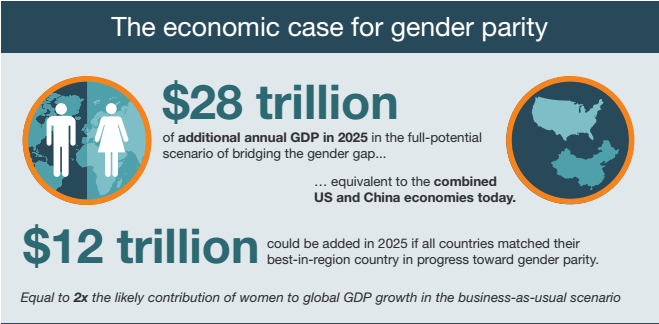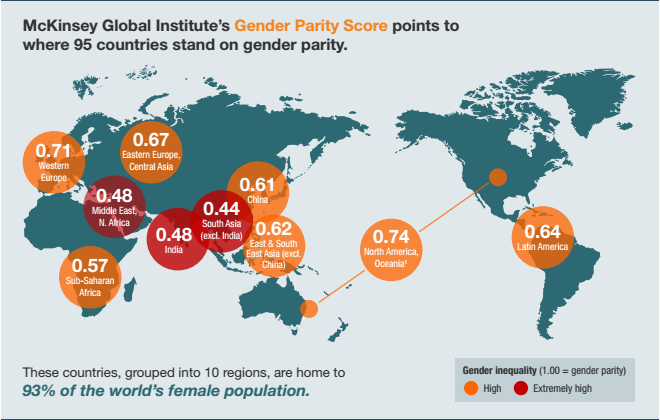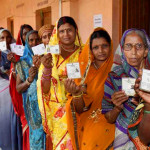News flash: investing in women and in gender equality pays off. It’s confirmed once more, attaining gender equality is not only the right thing to do but the smart thing to do. Whether it’s Lagarde backed by the IMF or the new fantastic report by Mckinsey Global Institute ‘The Power Of Parity: How Advancing Women’s Equality Can Add $12 Trillion To Global Growth’, they’re all saying it: gender parity in the workforce would boost the world economy. Roughly- in a scenario in which women participate in the economy identically to men, it would add up to $28 trillion, or 26%, to annual global GDP in 2025. This about represents the size of the combined US and Chinese economies today! Also, it turns out that India has the most to gain at empowering women and achieving gender equality in the workplace- out of all the other countries.


“Pushing gender equality can deliver a sizeable additional economic growth and could add Rs. 46 lakh crore (USD 700 billion) to India’s GDP in 2025” – NDTV Reports
I’ve taken a look at the report and the numbers so you don’t have to, and I’m reporting back. The most striking finding is that change concerning unpaid work would mean profound change in empowerment levels and GDP, and how the report puts the focus on the broader action that must be taken by the private sector. The report also highlights well that in order to gain higher levels of equality in the workplace, empowerment at other levels needs to happen simultaneously. We are talking about systematic multi-level change, where different areas must be targeted to achieve holistic change.
So how did McKinsey come up with the numbers?
- McKinsey Global Institute (MGI) has mapped 15 gender equality indicators for 95 countries and finds that 40 of them have high or extremely high levels of gender inequality on at least half of the indicators. The indicators fall into four categories: equality in work, essential services and enablers of economic opportunity, legal protection and political voice, and physical security and autonomy.
- MGI’s new Gender Parity Score, or GPS, measures the distance each country has traveled toward gender parity, which is set at 1.00. The regional GPS is lowest in South Asia (excluding India) at 0.44 and highest in North America and Oceania at 0.74.


Key results:
- Using the GPS, MGI found that greater equality at work was linked to gender equality in society, attitudes and beliefs about the role of women. Equality at work is not achievable without the other two elements. Economic development enables countries to close gender gaps, but progress in four areas in particular—education level, financial and digital inclusion, legal protection, and unpaid care work—could help accelerate progress.
- Six types of intervention are necessary to bridge the gender gap: financial incentives and support; technology and infrastructure; the creation of economic opportunity; capability building; advocacy and shaping attitudes; and laws, policies, and regulations.
- Tackling gender inequality will require change within businesses as well as new coalitions. The private sector will need to play a more active role in concert with governments and non-governmental organizations—and companies could benefit both directly and indirectly by taking action. We will see why.
In a nutshell- how would the increase in the GDP happen?
- First, women do not participate in the same numbers as men and simply increasing labour force participation would account for 54% of potential incremental GDP. Second, women work fewer hours than men and closing this gap would generate 23% of GDP opportunity. And finally, women are disproportionately represented in lower productivity sectors such as agriculture. Shifting women into higher productive sectors such as business services at par with the employment patterns of men would contribute another 23% of the total opportunity.
The gender gap in paid work is the results that 75% of global unpaid work—so child care, caring for the elderly, cooking and cleaning—is done by women. TO put this in perspective: the unpaid care work of women could be valued at $10 trillion of output per year. That amounts to roughly 13% of the global GDP. Therefore, although there is an inordinate focus on bringing women into the paid workforce, there is not enough focus on involving men more in family responsibilities, and to finding structural and institutional substitutes for the care work women do. Clearly there needs to be safety nets, and adjustments at every level to shift the responsibility in order for women for women to fully enter the workforce without leaving those they care without options. This is where private companies come in, bringing flexibility and options to their employees, for families and society to share the burden of care work. Private and public companies need to take some responsibility and acknowledge the need for a shift.
Modi had the right idea a month ago when he said “that he strongly believes in the power of women in society and added that if India expects to meet its economic goals then it can’t imprison 50 percent of its population at home- It needs to be a 100 percent partnership between men and women.
India’s potential
- India has the biggest relative scope to add GDP at 16% in a best-in-region scenario by 2025. The so-called best-in-region scenario in which all countries only match the rate of improvement of the best country in the region—could add $700 billion in the next 10 years. But the full potential boost would be as much as 60% in the next 10 years! If everything works out the way it should, or a so-called full-potential scenario happens, gender parity in the workforce could add $2.9 trillion to India’s 2025 GDP, (estimated at $4.83 trillion).
- MGI highlights that India has one of the world’s largest gender gaps when it comes to labour force participation, with women accounting for only 23-24% of the total labour force and generating a mere 17% of the share of GDP. This is far below the global average where female workers generate 37% of the world’s GDP.
- Any strategy to bridge gender gaps will need to recognize significant variations in inequality within the country. In its analysis for India, MGI has introduced a new score- an India Female Empowerment Index, or Femdex – to measure gender equality at the state level. The report found that a huge variation in gender equality among India’s 32 states. The average Femdex score of the top five states closest to gender parity are Mizoram, Kerala, Meghalaya, Goa, and Sikkim in the decreasing order while the bottom five are Bihar, Madhya Pradesh, Assam, Jharkhand, and Uttar Pradesh in the increasing order.


Levels of empowerment matter, in different sectors, and they translate to real value. These are just more reasons to give equal rights, opportunities and access to women across the world, and especially in India. If Indians needed yet another argument, here it is= Greed. India cannot afford to not empower women to enter the workforce, literally.
Donation for Centre for Social Research to Join our effort in rehabilitating Domestic Violence
Discuss this article on Facebook




